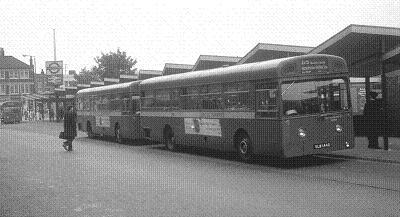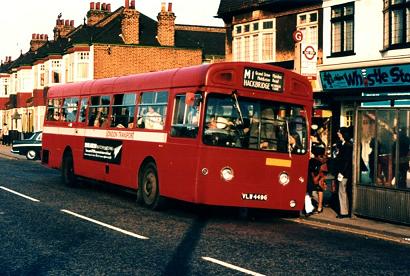 The Reshaping Plan The Reshaping Plan
The new Walthamstow Bus
Station in about 1974, six years after Reshaping changed the route
structure in the area for ever. MB144 is six years old and
already at the end of its life - it was withdrawn in 1974 and
scrapped in 1976.
Photo © John Law
The infamous Bus Reshaping Plan
of 1968 made major upheavals to long-standing patterns of service
and introduced areas of 'flat-fare' operation (now that all
London bus journeys cost the same, it is easy to forget that crews
used to have to cope with complex fare charts for each
route). These were numbered with a letter prefix based on the
area, thus starting with the W series and moving on to include
Peckham, Ealing and so on.
The idea behind Reshaping was to replace parts of the bus
network with a 'hub & spoke' arrangement, shortening trunk
routes and providing high-capacity local links. At the same time,
many suburban routes were converted to one-man operated buses. The
high-capacity routes were 'flat-fare' - i.e. the same price for any
distance, and used automatic fare machines on buses designed to
carry large numbers of standing passengers. The Plan was a
response to increasing staff problems and financial constraints at
London Transport.
Leon Daniels' tribute to Roy Smith, the architect of Reshaping
who died in January 2010, appears at the foot of this page.
Implementation started in September 1968 in the Wood Green
area (W routes W1 to W6 initially) and at Walthamstow (linked
with the opening of the Victoria Line), where only one new service
was flat-fare, the W21. The Wood Green area stretched from Crouch
End to Edmonton, and encompasses today's routes W1 to W10. The
Walthamstow area covers today's W11 to W19.
Reshaping, as first tried, was a disaster. Too much changed too
quickly, the buses were too long for some
of the roads and were unreliable, as was the fare equipment. And
passengers didn't like standing.
But the staffing and cost reasons behind all this were
irrefutable, and then Ken Livingstone came along with Fare's
Fair, so over time the old variable fares died out, first by
fixed-fare zones then London-wide. One-man (later one-person)
operation became inevitable, although some would argue the jury is
still out on the efficiency of OPO on high-frequency trunk
routes.
So the area schemes continued to be rolled out. Ealing (E
routes), Peckham (P routes, even though P1, P2 and later P4 didn't
go to Peckham), Morden (M routes) and Harrow (H routes) appeared by
1969. But the rot had set in - the Harrow scheme was a shadow of
the original proposal and Woolwich and Romford schemes never got
off the ground. A limited Croydon scheme (C routes, later
abandoned) went ahead in 1970 and some Stratford (S) routes in
1971. Later schemes were the Bexley area (B routes), Docklands (D
routes), Hounslow (H20 upwards), Kingston (K routes) Orpington (R
routes for 'Roundabout', the group name) and Uxbridge (U
routes).
Later examples of prefix route numbers tended to be local,
rather tortuous routes, introduced to get buses into streets not
previously served. This trend started with the minibus services in
1973 - see notes on the P4
for more detail - and continued with the likes of Sutton services
(S routes, including S3 which was previous used at Stratford) and
Richmond routes (R68 etc). There are still oddities, like G1,
presumably named after St Georges Hospital for which it's a local
service, and the PR and RV routes, mentioned at the end of the
article on the route number page.
Full details of the Reshaping Plan are set out in 'Reshaping
London's Buses' by Barry Arnold and Mike Harris, published by
Capital Transport in 1982. It is now out of print but worth
tracking down.
Leon Daniels of First Group wrote the following tribute on 29
January 2010:
I was saddened to learn today
of the death of Roy Smith, aged 87.
Roy was the first "senior" person at London Transport I ever knew.
He was sufficiently forward in his thinking to embrace the benefits
the private sector could deliver many years before tendering was
invented. Under his term of office we at Obsolete Fleet ran part of
the Round London Sightseeing Tour and invented new pick-up points.
We also ran Baker Street to The Zoo in place of supplementary 74s
and generally provided buses which the organisation could not do
itself.
But Roy's biggest challenge was as the architect of the Reshaping
Plan - this delivered widespread single-person operation to London
in a bold attempt to shorten routes, speed up boarding, and improve
reliability.
Sadly he was let down - mostly by the hardware. The buses were
hopelessly unreliable, the fare collection systems failed, and
revenue was way below what was expected. In due course the major
schemes morphed into simpler conversions to driver-only operation
but the main thrust of shorter and simpler routes remained.
For some reason commuters used to standing on the Underground and
suburban trains were less happy standing on buses, and illogically
people were concerned at only 25-33 seats on a bus even though the
average off-peak load on the old double-decker which had been
replaced was rather less than that. (Indeed if they had been
carrying 25-33 passengers the economic pressure to single-manning
would not have been so strong).
 It was ahead
of its time - today's two-door Dennis Darts equal the footprint of
the Swifts and Merlins but manage to run for several days without
disgracing themselves by the side of the road. Instead of
unreliable on-bus fare collection we now have mostly off-bus
ticketing.
Roy joined the LPTB in 1938 and was a bus traffic man mostly
throughout his career, retiring as Development Director (Buses) in
1981. He had been President of the LT Old Comrades Assocation and
Chairman of the Fifty Five Society.
I often tell newer staff that this business is "all about the
people" not the buses. Roy was one of those people and I am sure
history will record that he was very much ahead of his time.
MBS449 shown here on route
M1 - representing the short, flat-fare routes being introduced in
the suburbs as the plan Reshaping London's Buses was rolled
out. MBS444, a companion bus at Merton, is now
preserved.
Photo © Leon
Daniels
|